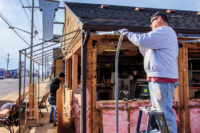Ask Annissa
Innovative Ideas to Transform the Restoration Industry
In this episode of Ask Annissa, she talks ways to improve the industry with technician Israel Ward.
As we all know, the restoration industry plays a crucial role in repairing and rebuilding communities affected by natural disasters, accidents, and other unforeseen events. As technology advances and customer expectations evolve, it is essential for the industry to continuously improve its practices and embrace innovative strategies.
In the video accompanying this article, Annissa covers several key areas where the restoration industry can enhance its operations, including leveraging advanced technologies, adopting sustainable practices, prioritizing customer experience, and fostering collaboration within the industry.
The following are just some of the ways to ensure industry improvement and growth.
1. Embracing Advanced Technologies: The restoration industry can greatly benefit from embracing cutting-edge technologies. Artificial intelligence (AI) and machine learning algorithms can be utilized to streamline the assessment and estimation process, enabling faster response times and more accurate cost projections. Drones equipped with high-resolution cameras can be employed to conduct aerial inspections, providing a comprehensive view of the damage. Additionally, 3D printing technology can be leveraged to quickly produce replacement parts and materials, reducing downtime and costs.
2. Adopting Sustainable Practices: In recent years, there has been a growing emphasis on sustainability across various industries. The restoration industry can contribute to this movement by adopting eco-friendly practices. This includes using environmentally friendly cleaning agents, implementing energy-efficient equipment, and promoting recycling and waste reduction. By incorporating sustainable practices, restoration companies can not only reduce their environmental impact but also attract environmentally conscious customers.
3. Prioritizing Customer Experience: Customer satisfaction should be at the forefront of every restoration company’s strategy. By providing exceptional customer service, companies can build trust, loyalty, and positive word-of-mouth referrals. This can be achieved by implementing user-friendly online platforms for easy communication and updates, offering transparent pricing and detailed progress reports, and ensuring prompt and efficient response times. Additionally, personalized post-restoration follow-ups can help gauge customer satisfaction and identify areas for improvement.
4. Fostering Collaboration within the Industry: The restoration industry can benefit greatly from fostering collaboration and knowledge-sharing among its stakeholders. This can be achieved through industry conferences, forums, and workshops where professionals can exchange ideas, discuss best practices, and learn from each other’s experiences. Collaboration can also extend to partnerships with other related industries, such as insurance providers, construction companies, and technology firms, to create a more holistic approach to restoration.
Improving the restoration industry requires a proactive approach that embraces innovation, sustainability, customer-centricity, and collaboration. By leveraging advanced technologies, adopting sustainable practices, prioritizing customer experience, and fostering collaboration within the industry, restoration companies can not only enhance their operations but also make a positive impact on the communities they serve. With a commitment to continuous improvement, the restoration industry can revolutionize its practices and ensure a more efficient and effective response to future restoration needs.
Looking for a reprint of this article?
From high-res PDFs to custom plaques, order your copy today!








